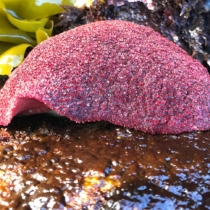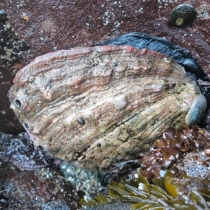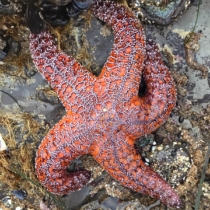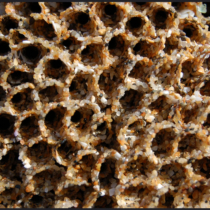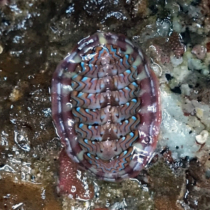By Emily Gottlieb, Pacific Grove Museum of Natural History
On a sunny afternoon in late October, a small group of students from an alternative high school were participating in the LiMPETS sand crab monitoring program at their local beach. Many had not been present for the in-class training a few days prior, so standing in the beach parking lot, they had a crash course in the monitoring protocol. They learned how to set vertical transects and collect their samples, how to measure and sex the crabs, how to return the crabs to the swash zone after collecting their data. After some half-hearted grumbles about getting their feet sandy, they had made their way down to the water. Once there, they followed the protocol meticulously, quickly forgetting their protests against the sand. After completing their survey, most of the students were wading in the shallow water or gathering their gear to return to the parking lot, but one student was hanging back. His towering 6-foot frame was bent over a small sandy child who had curiously wandered over with his mom. The high school student was gingerly holding a large sand crab and demonstrating how to lift the crab’s telson to reveal the bright orange eggs that she carried. The tiny beachcombers’ eyes went wide with fascination and the high school student was beaming — fully engaged in this teaching moment as he shared his newfound expertise.
Community science at the Pacific Grove Museum of Natural History tows the intersection between research and public education. It creates a space where science is equitable and accessible, reducing some barriers to participating in science by making it available to all. This is a value for all participants, and particularly those from groups that are underrepresented in science (women, people of color, immigrants, etc.). Community science participants get hands-on experience as scientists and they see themselves and their peers “doing” science — actually being scientists This can be a pretty powerful experience.
“It’s amazing how long-term monitoring of just one small species, like the Pacific Mole Crab, in one ecosystem can tell us a story about a much larger picture of impacts on the ecosystem. I love this program because when I reflect on when I was a high school student on a LiMPETS field trip, I know that experience is one of the main reasons I was able to be part of the program again and help from the other side. I believe that if more programs followed LiMPETS’ approach in offering hands-on experience in a natural setting, there would be a higher chance of that youth growing up and paying it forward to the youth of their generation.”
This quote comes from Akio, a student studying marine science at California State University Monterey Bay who volunteered with LiMPETS as a service learner in Spring 2018. It takes a community to raise a scientist like Akio; scientific literacy is imparted throughout a young person’s life. Teachers, mentors, family members and organizations like the Pacific Grove Museum of Natural History all play a role. While a day at the beach or river or monarch sanctuary may not spark a student’s interest in a lifelong science career, the concepts and practices that are enforced there will help that student navigate whatever path they choose. The Museum’s community science programs do more than provide a democratized space for participants to learn about local ecosystems and contribute to scientific understanding. These programs allow participants to see themselves in new roles and to illuminate potential paths that are available to them.
Read more about community science at the Pacific Grove Museum of Natural History here.

